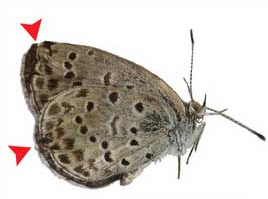If this news surprises you, you haven’t watched a lot of B-movies.
Exposure to radioactive material released into the environment could have caused mutations in butterflies found in Japan, a study has suggested.
Scientists found an increase in leg, antennae and wing shape mutations among butterflies collected following the 2011 Fukushima accident.

These images of “representative morphological abnormalities” are from the study, published in Scientific Reports. From left to right, dented eyes, deformed left eye, deformed right palpus, and deformed wing shape. Click to embiggen.
The researchers collected pale grass blue butterflies from a variety of locations around the site of the Fukushima Dai-ichi plant.
By comparing mutations found on the butterflies collected from the different sites, the team found that areas with greater amounts of radiation in the environment were home to butterflies with much smaller wings and irregularly developed eyes.
“It has been believed that insects are very resistant to radiation,” said lead researcher Joji Otaki from the University of the Ryukyus, Okinawa.
“In that sense, our results were unexpected,” he told BBC News.
Researchers took some of the butterflies to a location remote from the radioactivity and bred them; new mutations appeared in the offspring, suggesting that the butterflies suffered genetic damage. A second survey of insects in the zone around Fukushima six months after the first found a mutation level double the original survey. As the BBC notes:
[T]he findings from their new research show that the radionuclides released from the accident were still affecting the development of the animals, even after the residual radiation in the environment had decayed.
The implications are alarming and saddening. The exclusion zone around the nuclear plant is extensive, but is still home to many animals — both wild and once-domesticated — and even some people. This video was filmed in the exclusion zone within months of the accident, before the second survey described above.
If the mutations that are affecting the butterflies and their progeny similarly affect other creatures, the long-term impact could be significant. The Japanese government can enforce an exclusion zone for people (however imperfectly). Animals and birds are free to roam as they wish.



